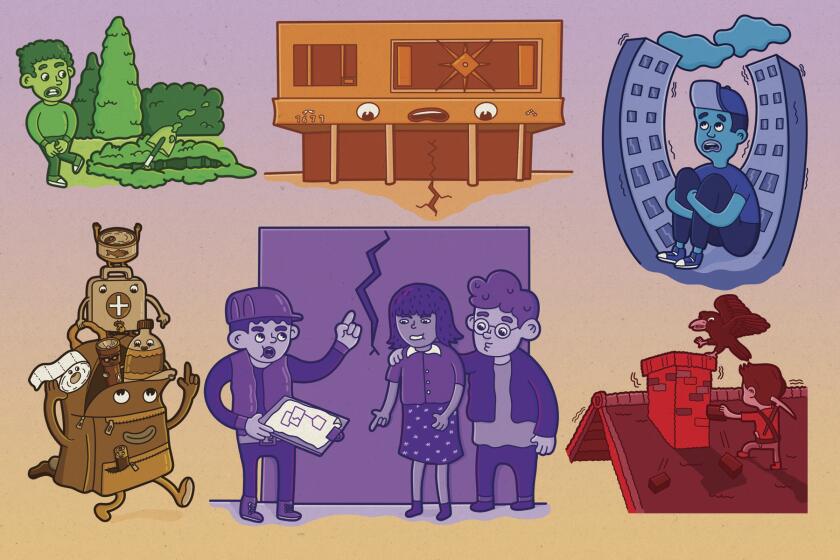Five takeaways from our expert panel on earthquake preparedness and resilience

Seismologist Lucy Jones and other earthquake experts from the Los Angeles Times and KPCC/LAist explain how to survive a major California quake.
- Share via
As a resident of earthquake country, do you know what to do when the Big One hits? If you’re like many Angelenos and Southern Californians, your answer might be no. But your answer can become yes with a little research and preparation. And that’s important to being ready for a big quake and resilient in its aftermath.
Here are five key takeaways from a discussion with seismologist Lucy Jones, Los Angeles Times earthquake reporter Rong-Gong Lin II, KPCC science reporter Jacob Margolis, Times columnist Patt Morrison and KPCC host Austin Cross. They spoke Thursday as part of “Local Matters: How to Survive the Big One,” a free community forum hosted by The Times and KPCC/LAist.
Preparation is key
When it comes to the Big One, the best thing you can do is be prepared.
“You don’t have to go into a hyperactive mode and start investing lots of money and time to do this. Very simple things can go a long way,” Lin said
Preparing yourself and your home can look different depending on your circumstances. If you live in a single-family home, consider bracing and bolting your foundation. If you live in an apartment building, talk to your landlord about seismic risks.
Jones said that the best thing you can do is invest in social capital. She said the more connections you have with your community, the better you’ll come out of any disaster — mentally and economically.
Margolis emphasized the point. “It’s really up to us to be self-sufficient, especially if you have access and functional needs or if you have a disability. There are many people who are just not going to be helped by the government, and we need to figure it out.”
Specific needs will require specific supplies. While there are things that everyone should have on hand, including water, food and extra clothing, Margolis said to keep in mind your, your family’s or your neighbors’ needs.
Need to keep medication cool? Consider investing in a generator. Does a caregiver help you get around? Make sure you consider them in your emergency plan.
At the end of the day, preparation is going to look different for each individual. But it’s important to keep in mind that any preparation at all is better than none.
“If you feel bad that you haven’t completed your perfect earthquake setup, don’t. Just get started today,” he said.
Get earthquake-ready in six weeks
From building a kit to buying insurance, our Unshaken newsletter course will help you prepare.
You may occasionally receive promotional content from the Los Angeles Times.
Early warnings
Earthquakes can happen at any time, and there’s no way to predict them.
But there are ways to be warned that the shaking is about to begin where you are.
Smartphone apps such as MyShake and Quake Alert USA are free to download for iOS users and can give you a few seconds’ warning that you’re about to experience an earthquake.
The time between when the shaking starts and when you get that alert, however, depends on several things.
“How many seconds is there between the lighting and the thunder?” Jones said. Like thunder and lightning, how intensely and when you feel an earthquake depends on how close you are to the epicenter. The farther away you are, the more time you’ll have to run under a table and the less intense it’ll feel. The closer you are, the less time you’ll have, and the shaking will be much more intense.
Japan has a sophisticated system to alert its residents, and Mexico City has ubiquitous sirens. Is California’s early warning system ready?
What to expect
The possibility of the Big One has made headlines, hit movie screens and stalked the imaginations of Angelenos for years. But what can you really expect?
To put it simply: “Everyone is going to experience a Big One, no matter where you live,” according to Jones.
The one we’ve been preparing for is totally normal in the seismic history of California. Jones said a large earthquake occurs on average every 100 years, and we have about a 1% chance every year of experiencing the next one.
Lin warned that Angelenos should be ready for life to change drastically.
“We haven’t had a major, catastrophic earthquake in California in the world of smartphones and Twitter, so one thing to really imagine is expecting cellphone service to go down,” he said.
Try to text loved ones to let them know you’re OK once the shaking has stopped. But as part of your preparation, he suggested, write down phone numbers of loved ones so you can still contact them via landline.
Margolis suggested having a radio on hand to prevent you from missing any crucial information after a quake.
“I think it’s hard for people to understand how disrupted life after the earthquake is going to be,” Jone said.
The earthquake itself, while it may cause serious damage, isn’t the only thing that Angelenos will have to contend with. Experts expect that fires will be caused by downed power lines and natural gas leaks, and landslides could be triggered. But “the financial losses from the fire would be as large as from the earthquake itself,” Jone said.
Housing, a crisis that Angelenos are far too familiar with, would be worsened by “the big one.” A quarter of a million people in Southern California could become homeless after a large earthquake, she said.
“Think about how existing inequalities, existing trouble in our economic systems or human systems, they will fall where they are already weak. And if we have a struggling economy, and then hit it with the earthquake, we’re going to suffer a lot more than if we have the resources to rebuild,” Jones said.
When the Big One hits, will Californians be ready for a lack of modern communication connections? Extended periods without essential utilities such as water and gas? Damage to homes? The mental health effects that often follow disaster?
What to do during the earthquake
Once you feel that shaking start, Jones said there’s only one thing to do: Drop, cover and hold on.
Don’t run. Jones said she understands that your primal instinct may be telling you to run. But if the earthquake is big enough to hurt your house, it’ll certainly hurt you. It’s better to hunker down and ride it out.
Other methods of seeking safety, such as standing in a door frame of creating a “triangle of life” (which she called “a con”) are not effective.
“We really do know that it’s the safest thing to do,” she said. “Almost certainly your house is not collapsing, but almost certainly things are going to be thrown around your house.”
So get on the ground, get under something sturdy and cover your head and neck, and hold on until the shaking stops.
Drop, cover and hold on is the best advice for what to do during an earthquake. Know how you’ll react so you can stay calm and act quickly when the shaking begins.
Keep it in perspective
Earthquakes are scary — no one can deny that. But there are some things to keep in mind to put it all into perspective.
“We are inordinately afraid of dying in an earthquake,” Jones said. “Even though our freeways are far more dangerous and in fact you’re far more likely to be murdered in California than to die in an earthquake.”
More people, she said, have died of COVID-19 in California than would realistically die in an earthquake.
Living in California means you’re going to experience an earthquake. Jones said that when she was younger, no one talked about them because that would mean you were admitting that there was a downside to living in the Golden State.
But Lin reminded viewers that “earthquakes made California” — its natural landscapes that we love for their beauty. And without all of our seismic activity, Los Angeles and Southern California wouldn’t be the city and region we all know and love.
For more on how to prepare for an earthquake, go to latimes.com/unshaken.
Earthquake preparedness is about communication, resilience and understanding and mitigating your risks. Our newsletter course will teach you how.
More to Read
Sign up for Essential California
The most important California stories and recommendations in your inbox every morning.
You may occasionally receive promotional content from the Los Angeles Times.










![Vista, California-Apri 2, 2025-Hours after undergoing dental surgery a 9-year-old girl was found unresponsive in her home, officials are investigating what caused her death. On March 18, Silvanna Moreno was placed under anesthesia for a dental surgery at Dreamtime Dentistry, a dental facility that "strive[s] to be the premier office for sedation dentistry in Vitsa, CA. (Google Maps)](https://ca-times.brightspotcdn.com/dims4/default/07a58b2/2147483647/strip/true/crop/2016x1344+29+0/resize/840x560!/quality/75/?url=https%3A%2F%2Fcalifornia-times-brightspot.s3.amazonaws.com%2F78%2Ffd%2F9bbf9b62489fa209f9c67df2e472%2Fla-me-dreamtime-dentist-01.jpg)







